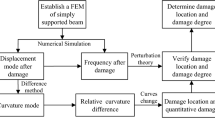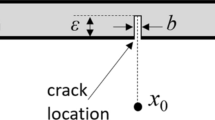Abstract
The sensitivity of the nonlinear dynamic response to damage is investigated in simply supported beams by computing the nonlinear normal modes (NNMs) and exploiting the rich information they unfold about the nonlinear system behavior. Damage is introduced as a reduction of the flexural stiffness within a small segment of the beam span. The problem is formulated in a piece-wise fashion and analytically tackled by using the method of multiple scales to compute the NNMs and the backbone curves. The latter describe the frequency versus free oscillation amplitude for each mode and as such they represent the skeleton of the nonlinear frequency response around each beam modal frequency. The bending of the backbones is regulated by the so-called effective nonlinearity coefficients associated with each mode. The comparison between the damaged and undamaged beams shows a sensitivity of the effective nonlinearity coefficients higher than the sensitivity of the linear natural frequencies. Moreover, the nonlinear frequency trends unfold an interesting dependence of the nonlinear free response on the stiffness reduction at the damage site. Such dependence yields useful information about the damage position. An effective identification strategy for the damage position is proposed by computing the damage-induced discontinuities in the second derivative of the NNMs (i.e., first order estimate of the bending curvature), without resorting to a baseline model of the undamaged beam. This goal is achieved by computing a high order derivative of the Nadaraya–Watson kernel estimator, which is evaluated from a finite set of sampled beam deflections associated with each individual NNM. The results show that the second derivatives of higher NNMs are more sensitive to damage-induced discontinuities than the linear modal curvatures. The robustness against noise of the damage identification process is also discussed.










Similar content being viewed by others
References
Andreaus U, Casini P, Vestroni F (2007) Non-linear dynamics of a cracked cantilever beam under harmonic excitation. Int J Non-linear Mech 42(3):566–575
Benedettini F, Dilena M, Morassi A (2015) Vibration analysis and structural identification of a curved multi-span viaduct. Mech Syst Signal Process 54:84–107
Benfratello S, Cacciola P, Impollonia N, Masnata A, Muscolino G (2007) Numerical and experimental verification of a technique for locating a fatigue crack on beams vibrating under Gaussian excitation. Eng Fract Mech 74(18):2992–3001
Bornn L, Farrar C, Park G (2010) Damage detection in initially nonlinear systems. Int J Eng Sci 48(10):909–920
Carboni B, Lacarbonara W (2012) A three-dimensional continuum approach to the thermoelastodynamics of large-scale structures. Eng Struct 40:155–167
Casini P, Giannini O, Vestroni F (2006) Experimental evidence of non-standard bifurcations in non-smooth oscillator dynamics. Nonlinear Dyn 46(3):259–272
Casini P, Vestroni F (2004) Nonstandard bifurcations in oscillators with multiple discontinuity boundaries. Nonlinear Dyn 35(1):41–59
Chati M, Rand R, Mukherjee S (1997) Modal analysis of a cracked beam. J Sound Vib 207(2):249–270
Chu Y, Shen MH (1992) Analysis of forced bilinear oscillators and the application to cracked beam dynamics. AIAA J 30(10):2512–2519
Corrado N, Gherlone M, Surace C, Hensman J, Durrande N (2015) Damage localisation in delaminated composite plates using a Gaussian process approach. Meccanica 50(10):2537–2546
Curadelli R, Riera J, Ambrosini D, Amani M (2008) Damage detection by means of structural damping identification. Eng Struct 30(12):3497–3504
Dessi D, Camerlengo G (2015) Damage identification techniques via modal curvature analysis: overview and comparison. Mech Syst Signal Process 52–53:181–205
Dilena M, Morassi A, Benedettini F, Eusani F (2009) Dynamical tests on a damaged bridge. In: Proceedings of the 3rd IOMAC international operational modal analysis conference, pp 577–584
D’Souza K, Epureanu B (2005) Damage detection in nonlinear systems using system augmentation and generalized minimum rank perturbation theory. Smart Mater Struct 14(5):989–1000
Gauthier J, Whalen T, Liu J (2008) Experimental validation of the higher-order derivative discontinuity method for damage identification. Struct Control Health Monit 15(2):143–161
Gijbels I, Goderniaux AC (2005) Data-driven discontinuity detection in derivatives of a regression function. Commun Stat Theory Methods 33(4):851–871
Lacarbonara W (2013) Nonlinear structural mechanics: theory, dynamical phenomena and modeling. Springer, Berlin
Lacarbonara W, Camillacci R (2004) Nonlinear normal modes of structural systems via asymptotic approach. Int J Solids Struct 41(20):5565–5594
Lacarbonara W, Yabuno H, Hayashi K (2007) Non-linear cancellation of the parametric resonance in elastic beams: theory and experiment. Int J Solids Struct 44(7):2209–2224
Quaranta G, Carboni B, Lacarbonara W (2012) On the reliability of a PCA-based method for structural diagnosis in bridge structures with environmental disturbances. MATEC Web Conf 1:01–002
Quaranta G, Carboni B, Lacarbonara W (2016) Damage detection by modal curvatures: numerical issues. J Vib Control 22:1913–1927
Ratcliffe C (1997) Damage detection using a modified Laplacian operator on mode shape data. J Sound Vib 204(3):505–517
Rosenberg R (1961) On normal vibrations of a general class of nonlinear dual-mode systems. J Appl Mech 28(2):275–283
Silverman BW (1986) Density estimation for statistics and data analysis. Chapman and Hall, London
Surace C, Archibald R, Saxena R (2013) On the use of the polynomial annihilation edge detection for locating cracks in beam-like structures. Comput Struct 114–115:72–83
Vestroni F, Benedettini F (2010) Dynamical tests and analysis for the assessment of structural conditions of bridges. In: International association for bridge and structural engineering (IABSE symposium report), vol 97, pp 46–53
Vestroni F, Luongo A, Paolone A (2008) A perturbation method for evaluating nonlinear normal modes of a piecewise linear two-degrees-of-freedom system. Nonlinear Dyn 54(4):379–393
Xu Y, Zhang J, Li J, Xia Y (2009) Experimental investigation on statistical moment-based structural damage detection method. Struct Health Monit 8(6):555–571
Acknowledgments
The financial support of Lacarbonara and Carboni through a 2010–2011 MIUR (Italian Ministry of Education, University and Scientific Research) PRIN Grant and 2013 Sapienza Grant is gratefully acknowledged. The work of Quaranta is framed within the project DPC–ReLUIS, RS 4 “Osservatorio sismico delle strutture e monitoraggio”.
Author information
Authors and Affiliations
Corresponding author
Appendix
Appendix
The resonant nonlinear force generated by the jth mode at third order can be piece-wise expressed as
If the lower summation index in Eq. 34 is greater than the upper index in the summations, the associated result is set to zero.
The function \(f_j(x)\) representing the span-wise force distribution associated with the third harmonic \(A_j^3 \hbox {e}^{3{\mathrm {i}} \omega _j T_0}\) is expressed as
Rights and permissions
About this article
Cite this article
Lacarbonara, W., Carboni, B. & Quaranta, G. Nonlinear normal modes for damage detection. Meccanica 51, 2629–2645 (2016). https://doi.org/10.1007/s11012-016-0453-8
Received:
Accepted:
Published:
Issue Date:
DOI: https://doi.org/10.1007/s11012-016-0453-8




